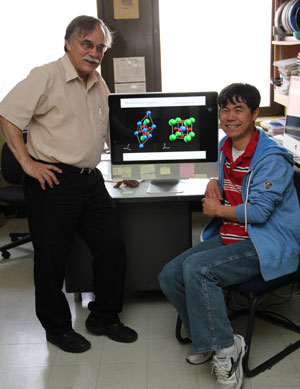| Jun 21, 2013 |
Scientists solve riddle of strangely behaving magnetic material
|
|
(Nanowerk News) Materials scientists at the U.S. Department of Energy’s (DOE) Ames Laboratory have found an accurate way to explain the magnetic properties of a compound that has mystified the scientific community for decades.
|
|
The compound of lanthanum, cobalt and oxygen (LaCoO3) has been a puzzle for over 50 years, due to its strange behavior. While most materials tend to lose magnetism at higher temperatures, pure LaCoO3 is a non-magnetic semiconductor at low temperatures, but as the temperature is raised, it becomes magnetic. With the addition of strontium on the La sites the magnetic properties become even more prominent until, at 18 percent strontium, the compound becomes metallic and ferromagnetic, like iron.
|
|
“It’s just strange stuff. The material has attracted a lot of attention since about 1957, when people started picking it up and really studying it,” said Bruce Harmon, senior scientist at the Ames Laboratory. “Since then, there have been over 2000 pertinent papers published.”
|
 |
| Bruce Harmon (left) and Youngbin Lee.
|
|
Traditional theories to describe the compound’s behavior originated with physicist John B. Goodenough, who postulated that as temperature rises, the spin state of the d-electrons of cobalt changes, yielding a net magnetic moment.
|
|
“Back then it was more of a chemist’s atomic model of electron orbits that suggested what might be going on,” explained Harmon. “It’s a very local orbital picture and that theory has persisted to this day. It’s become more sophisticated, but almost all the theoretical descriptions are based on that model.”
|
|
But when Ames Laboratory research partners at the Argonne National Laboratory and the University of California, Santa Cruz performed X-ray absorption spectroscopy measurements of the material, the theory didn’t fit what they were observing.
|
|
”They knew that we could calculate x-ray absorption and magnetic dichroism, so we started doing that. It is a case where we fell into doing what we thought was a routine calculation, and it turned out we discovered a totally different explanation,” said Harmon. “We found we could explain pretty much everything in really nice detail, but without explicitly invoking that local model,” said Harmon.
|
|
The scientists found that a small rhombohedral distortion of the LaCoO3 lattice structure, which had largely been ignored, was key.
|
|
“We found that the total electronic energy of the lattice depends sensitively on that distortion,” explained Harmon. “If the distortion becomes smaller (the crystal moves closer to becoming cubic), the magnetic state of the crystal switches from non-magnetic to a state with 1.3 Bohr magnetons per Co atom.”
|
|
Ames Laboratory scientists Bruce Harmon and Yongbin Lee partnered with the researchers at the Argonne National Laboratory and the University of California, Santa Cruz to publish a paper in Physical Review Letters, “Evolution of Magnetic Oxygen States in Sr-Doped LaCoO3”.
|
|
This new understanding may help the further development of these materials, which are easily reduced to nanoparticles; these are finding use in catalytic oxidation and reduction reactions associated with regulation of noxious emissions from motor vehicles.
|
|
Yap has filed for a full international patent on the technology.
|

